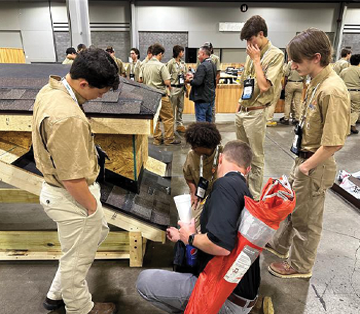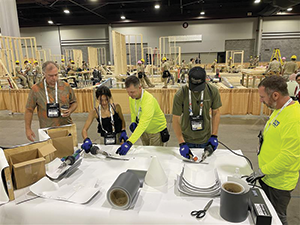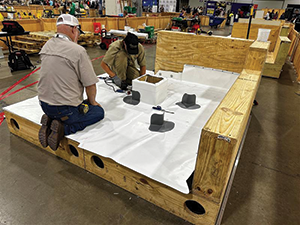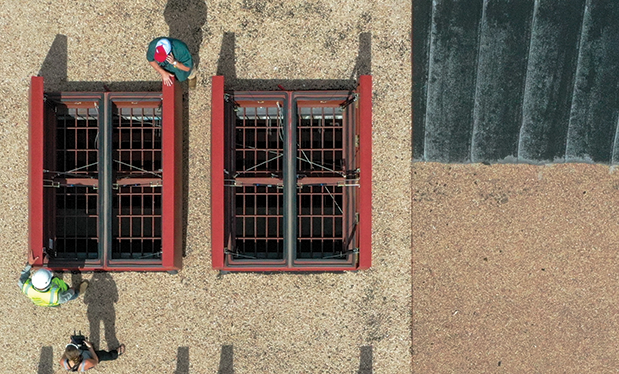
I recently attended SkillsUSA’s National Leadership and Skills Conference in Atlanta. Held each year, the expo and competition serve as an Olympics of sorts for the trades. Young people from throughout the U.S. compete in more than 100 competitions in the skills, crafts and trades genres. Having participated in local, state and regional competitions to qualify, participants come together to determine the best student in the nation in each craft.
It’s a sight to behold.
If you have attended the International Roofing Expo,® imagine something with about three times the square footage, more than 6,500 competitors and more than 15,000 attendees.
There are competitions for carpentry, masonry, electronics, robotics, computer programming, baking and culinary arts, cosmetology, welding and mechanics of all sorts and sizes (there was a complete jet engine in the hall, for example). You name it. If a job of any sort is done largely with one’s hands, there is likely a competition occurring at this event.
But until recently, none of those 6,500 competitors had anything to do with roofing. The roofing industry wasn’t a part of it.
Missing out on exposing 6,500 craft-minded young people to the roofing industry is painful; after all, these kids are the best students at what they do. But for me, the bigger pain point is the hundreds of thousands of students who didn’t make it to the “Olympics” because they weren’t exposed to roofing in the first place.
Think of the traditional Olympics. The 2021 men’s U.S. Olympic baseball team had 24 players. But in 2022, there were more than 481,000 teens playing high school baseball, and more than 15.6 million kids playing baseball in youth leagues. So sure, it’s terrific for baseball to have a team in the Olympics, but the far more important indicator of exposure to the game comes from those who are much earlier in their sporting paths.
On opening day of the 2022 Major League Baseball season, there were 975 players. Those 975 would have never started their journeys to being professional baseball players were it not for some initial exposure to the game. You have to know something exists and is an option before you can even consider pursuing it! And then follow up that exposure with training, coaching and support in skills development.
Side note: This season, 269 MLB players are from foreign countries. They are immigrants here to do a job in a profession that sought them and their skills. It’s odd; I haven’t heard politicians and anti-immigration activists yelling about this. Hundreds of millions of dollars in wages are going to noncitizens, but not a peep of outrage about immigrants stealing those jobs. When the Washington Nationals won the World Series in 2019, the victory was significantly aided by Juan Soto of the Dominican Republic. He barely spoke English and was 20 years old. Someday, this nation will have an immigration policy that works for all trades and 20-year-olds looking to work hard and get ahead—not just those who can swing a bat. But let’s table this rant for now and get back to improving young people’s exposure to roofing.

NRCA began its involvement with SkillsUSA just a few years ago, and this is the first year the roofing industry is a part of the event. Four young adults competed, and Kyle Cameron from Hutchinson, Kan., took home the top prize (which, in addition to bragging rights, also came with a $1,000 cash prize). This is a terrific step and an exciting moment for our industry. But the exposure that comes from having the industry be a part of this event is the long-term value. There were thousands of trade school educators at the competition chaperoning their students, walking the show floor, attending educational sessions, etc. And these educators are also now seeing roofing and learning a bit of what it entails.
I attended a session NRCA staff held for students and educators titled Commercial Roofing 101, and at the end of the session, a teacher from the Midwest approached me and said: “I’d like to get this in my class, who can I connect with?”
Oh man, no better words were spoken all week.
Similar exchanges happened on the competition floor as educators and students interacted with low- and steep-slope mockups, welded some membrane and (probably for the first time) got a sampling of what takes place on roofs. A terrific moment!
But now comes the next step: getting the industry to partner with these trade schools. That means you. You are the industry. The students and teachers are willing. The enthusiasm, interest and aptitude are there. They just need some expert help.
Let’s go back to baseball. On each of those T-ball and Little League teams, there is a kid sitting down in the outfield or getting distracted by an airplane flying overhead. But there also is a volunteer coach giving a little of his or her time to expose those children to the game. Many of you have probably done it in some fashion for some sport or activity you or your children care about. Despite how busy you are, you give a few hours per week for a few months for love of the game or love of the next generation.
Isn’t this profession, your business, your industry worth about as much time? NRCA and its partners can increase exposure to vital audiences, but it takes folks on the ground to build the momentum. We have dozens of contractors and staff who can provide resources, advice, best practices, curriculum and contacts to help you step into a trade school and share what you know one evening per week for a few weeks at a school likely just down the road from you.

You shouldn’t even look at it as volunteering or donating because it’s an investment. And one that has a proven track record of paying off. The companies that have actively engaged with their local trade schools come away with a few new employees every semester. What’s a trained, enthusiastic, hardworking young individual worth to your company in the current labor market?
Ultimately, if you won’t do it, who will? Perhaps a competitor. Perhaps no one, and that would be the worst outcome because it means the industry loses another opportunity to help solve its labor shortage by letting willing workers go to other trades.
Solving individual company labor shortages doesn’t need to be a field of dreams; your colleagues already have proved if you build it, they will come. You just need to be willing to tap into your internal Kevin Costner and “go the distance.”
To get complete, step-by-step assistance in recruiting the next generation of roofing workers for your company, contact John Esbenshade, NRCA’s director of workforce development, at jesbenshade@nrca.net.
MCKAY DANIELS is NRCA’s CEO.
mdaniels@nrca.net



